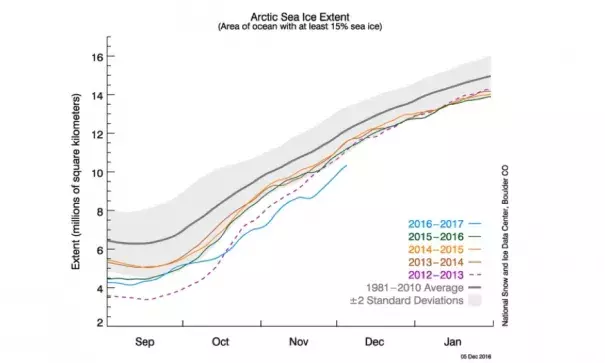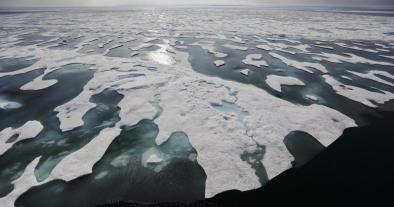Arctic Sea Ice Sees Strange Cold Season Retreat

The Arctic is missing a chunk of sea ice the size of Mexico.
While fall ushers in the season of sea ice growth, November saw a brief retreat that was virtually unprecedented in nearly 40 years of satellite records, according to data released Tuesday by the National Snow and Ice Data Center. That dip helped November set a record low for sea ice area — the seventh month to do so this year, also a record.
...
But skyrocketing Arctic temperatures, which are rising twice as fast as the global average, have set off a downward spiral in sea ice levels. Summer has seen the biggest decline, with the end-of-season minimum half of what it was just three decades ago.
...
The end-of-winter maximum this year hit a record low thanks to remarkably warm winter conditions in the Arctic, with air temperatures 4°F to 11°F (2°C to 6°C) above average. But relatively cool and cloudy summer weather kept the summer minimum from beating out the 2012 record low.
As the sun set for the winter, ice began to grow like usual, though it stayed well below normal week after week.
Then, in mid-November, an odd thing happened: the sea ice began to decline. Before it resumed its upward trajectory, sea ice area dropped by 19,300 square miles — a feat virtually unprecedented in the records. The only similar occurrence was a much smaller drop of 5,400 square miles in November 2013.
That unusual cold-season dip helped November finish with a sea ice area 753,000 square miles below the 1981 to 2010 long-term average for the month (even though the growth rate of sea ice was slightly higher than average), just a bit smaller than the area of Mexico.
The strange cold-season dip in sea ice extent was caused by persistent southerly winds pulling in warm air and warm ocean waters that kept sea ice from forming in the Barents Sea, an area north of Scandinavia and eastern Russia. Sea surface temperatures there were up to 7°F (4°C) above normal during November near Norway’s Svalbard Peninsula.
Related Content



